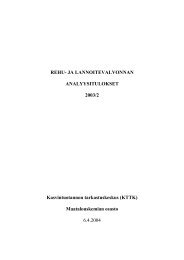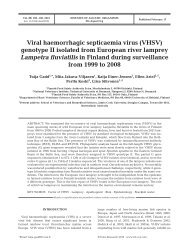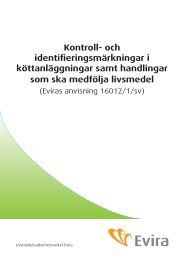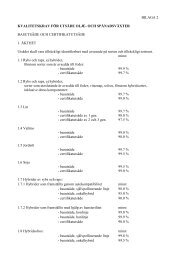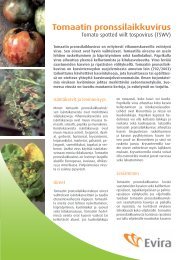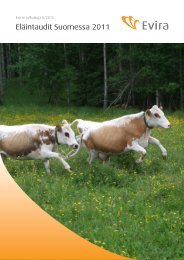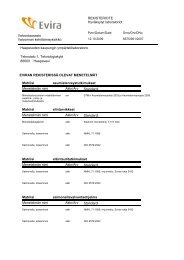Molecular characterization of endemic salmonella infections ... - Evira
Molecular characterization of endemic salmonella infections ... - Evira
Molecular characterization of endemic salmonella infections ... - Evira
You also want an ePaper? Increase the reach of your titles
YUMPU automatically turns print PDFs into web optimized ePapers that Google loves.
Genomic sequences derived from temperate phages in S. Typhimurium were used to design<br />
primer sets, which were used to analyse sequence variations <strong>of</strong> prophage loci. The typing was<br />
based on the presence or absence <strong>of</strong> an amplified product. This multiple amplification <strong>of</strong> phage<br />
locus typing (MAPLT) was more discriminatory than PFGE and MLST with the housekeeping<br />
genes (fhuA, sucA, tonB, manB, glnA), regardless <strong>of</strong> phage type (Ross and Heuzenroeder 2005b).<br />
Multiple-locus variable-number tandem-repeats analysis (MLVA) and variable number <strong>of</strong> tandem<br />
repeats (VNTR)<br />
The variable number <strong>of</strong> tandem repeats (VNTR) belong to a class <strong>of</strong> repetitive DNA that appears to<br />
contain a high level <strong>of</strong> polymorphism, thereby giving the VNTR-based typing a high discriminatory<br />
capacity (Lindstedt et al 2003). The multiple-locus variable-number tandem-repeats analysis<br />
(MLVA) is based on capillary separation <strong>of</strong> multiplexed PCR products from VNTR loci in the<br />
bacterial genome. These PCR products are labeled with fluorescent dyes (Lindstedt et al 2003,<br />
2004). The VNTR-based method has a greatly superior discrimination within the highly<br />
homogenous S. Typhimurium DT104 phage type compared to those <strong>of</strong> XbaI PFGE, AFLP and<br />
integron pattern analyses (Lindstedt et al 2003). These authors also observed a high correlation<br />
between MLVA clusters and PFGE clusters <strong>of</strong> S. Typhimurium (Lindstedt et al 2003, 2004).<br />
However, the MLVA method is not suitable for predicting phage types, as it does not group all the<br />
similar phage types within the same MLVA clusters, even though a correlation with the S.<br />
Typhimurium phage types was found (Lindstedt et al 2004). MLVA was effective in identifying a<br />
regional outbreak <strong>of</strong> S. Typhimurium DT12 in Denmark and locating its source, whereas the<br />
routinely used PFGE did not discriminate between the isolates (Torpdahl et al 2006). MLVA was<br />
evaluated, and compared with PFGE and phage typing, for subtyping S. Enteritidis. It was<br />
concluded that MLVA was more discriminatory than PFGE and phage typing among nonepidemiologically<br />
in addition to epidemiologically linked isolates. MLVA also was found to have<br />
good reproducibility (Boxrud et al 2007).<br />
2.5.2.7 DNA microarray<br />
The DNA microarray methodology allows assessment <strong>of</strong> differences and changes in bacterial<br />
genomic contents. It has been widely used for comparative Salmonella research since genomic<br />
comparison <strong>of</strong> S. enterica serovars and S. bongori were performed by Chan et al in 2003. Porwollik<br />
et al (2004) found that gene contents sometimes differed more within a serovar than between<br />
serovars. The Salmonella strains that share a distinct pr<strong>of</strong>ile <strong>of</strong> gene content are called genovars.<br />
Two distinct groups among 13 strains <strong>of</strong> serovar Typhimurium DT104 were identified by a<br />
prototype DNA microarray developed for strain differentiation (Pelludat et al 2005). Cooke et al<br />
(2007) used microarrays to detect genes that exhibit significant genetic variation in S.Typhimurium,<br />
37



